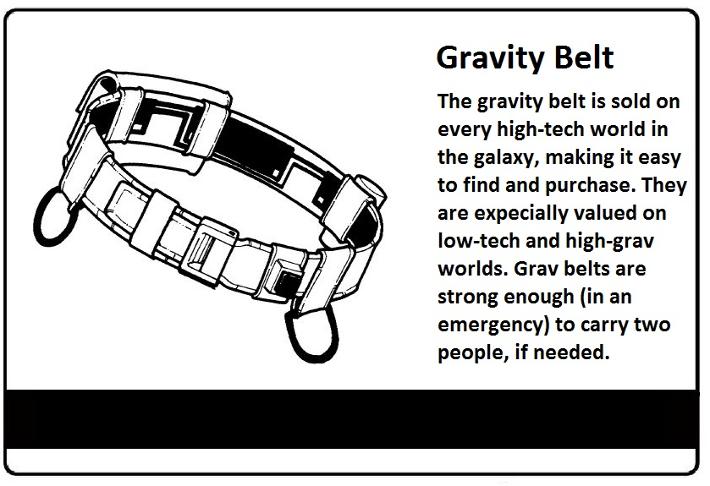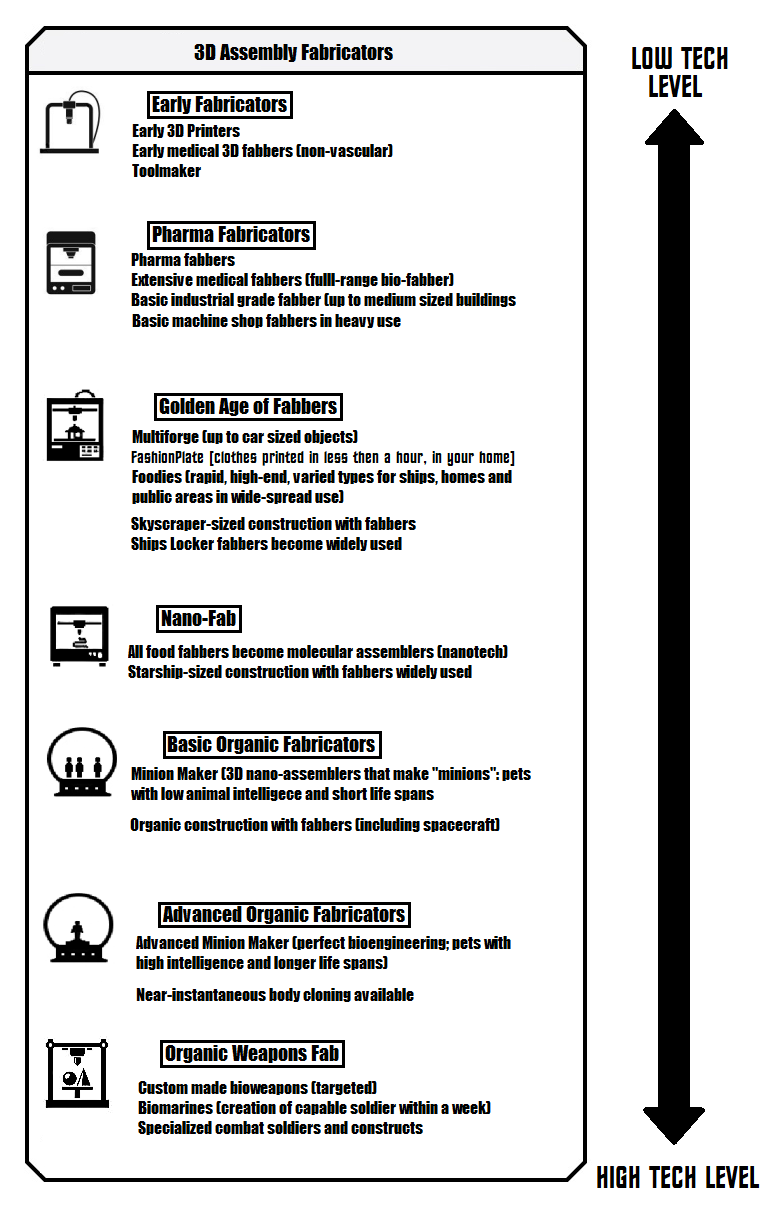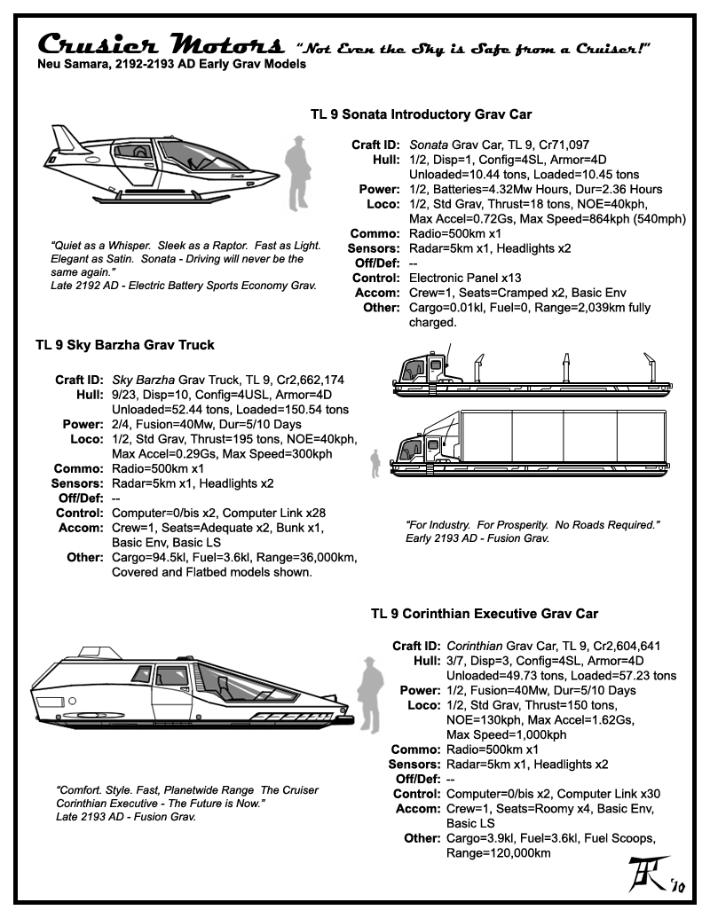


AUGMENTS
Popular civilian and military types
Augmentations or Augs are cybernetic devices that increase the abilities of people and most of the higher-end ones are of military design. Augs are generally brain-computer interfaces that are extremely common on high-tech worlds, and rare on low-tech ones. They use a wide-range of useable software. Some of the most popular augs on human worlds are listed below. Additionally, all cybernetics are extremely vulnerable to high energy particles like tachyons, neutrinos, and mesons.
CIVILIAN AUGS
Bio-Maintenance Aug: a typical biological enhancer implant that boosts a persons immunity system tenfold. It is also a alcohol blocker, a instant awareness booster (from sleep, stasis sickness, or drunkenness), and a auto-healer (nano). It also has a health watcher option (a broad health scanner, including blood pressure, blood glucose, etc), and is a standard e-dcotor that knows your entire case history and is designed to keep you in optimal health. Also has a contraceptive function that can be turned on or off. It also measures the concentration of various molecules in your blood, and can be used as a pain suppressor
Body Ink: A full-body electronic ink tattoo. You can keep your own skin tone but its fully customizable; you can create any skin tone necessary, birth marks, and tattoos. Widely available in civilian circles.
Civilian-grade Sensor Aug: This implant is a standard package used by most civilians in a high-tech society. It is usually mounted under the hair on the head, and has the following functions: local audio recorder, environmental sensor (with danger options), back-up networking option, med-sensor options, smell/taste sensor, augmentator and filter
Cogito: this is a brain implant that increases cross-brain connectivity which significantly boosts critical thinking and creativity. It also expands raw intelligence by 15-20% above a baseline humans' brain. The hardware can also increases a persons' memory capacity by up to 50%, depending on the subject as well as adding near-total recall of information. Cognito is a standard brain implant for citizens from planets with a very high tech level.
Cram: Originally developed as a treatment for people with memory related disorders, this aug became highly popular amongst students on the black market on worlds with significant legal cybernetic restrictions. This pea-sized aug is a storage collection memory device, encapsulated in a delivery system designed to maintain optimum mentality over 8-10 hours (in other words throughout a night). Shortly after activation, Cram grants a window of eidetic memory, allowing users to process and remember great amounts of information with high fidelity all the while feeling constantly motivated. Lower tech level versions of this aug suffered from potentially harmful side effects by causing a strong retention of the user's emotional state (ie a recently bereaved user attempting to learn a subject will always associate that subject with pain). More sophisticated versions of this aug (TL17 and higher) using nanite clusters of reactive nanoparticles remove this effect by creating a more selective effect.
Info Node: One of the typical implants that humans receive in utero (or in vitro) as a fetus, it grows in complexity as person grows into adulthood. It typically serves many functions, especially as net agents for the owner. These agents constantly search the local information network as serve as secretaries, librarians, data-valets, and even personal stand-ins. Info nodes are located in the brain and are grown through nanotechnology. They are a critical function of expanding ones e-memory. It also is the basis for all basic education as child grows into adulthood. These nodes also encompass a broad array of civilian options, including EM telepathy, auto-translators, e-conferencing in virtual space, access to weather, medical access, virtual entertainment, personal access to e-memory, e-pedia information feeds, travel data, life journals, and hundreds of other data downloads necessary for a normal (fast-paced) life in the modern world (TL12 or higher). MORE HERE SOON (Control machines with your mind)
Insight: The true veracity of this aug has always been hotly contested. The action of this cybernetic implant is to cause the user to fall into a lucid state filled with mild hallucinations, usually involving memories from the user's past. Whilst in this state the aug is designed to help the user find patterns, connections and revelations. There are many anecdotal accounts of this resulting in profound positive effects on the individual's personality and of genius moments of insight leading to ground breaking academic work. However for every account of positive results there are accounts of users who have come away paranoid, or obsessed with a fallacious idea. User caution is advised.
MILITARY AUGS
Speedo: This cybernetic implant directly affects a soldiers movement, causing bursts of speed for up to ten minutes by 25% above normal. It should be used sparingly on the battlefield because of enormous chemdrain side effects, it is one of the more popular augs with the troops and is located in the pituitary gland.
Nightingale: This is a military-grade cybernetics device (an augmentation) that is typically located near the heart of a soldier and can call for aide when a soldier is in danger of dying. Nightingale also sends information about the health of an individual to local leaders, and sometimes military headquarters as well. Its primary role is to be able to call for evacuation on its own for a soldier if he/she is seriously injured. Nightingale also has a secondary healing storage unit that deals mainly with light wounds and also can flood the body with pain suppressors as well as dealing with shock. This aug is standard for high-tech troops from advanced technology worlds. The Nightingale is named after a famous pre-spaceflight nurse from Olde Earth.
Testament: This is a cybernetic system that are disguised to look like harmless medical implants, but they secretly record the last 24 hours of a persons life. When retrieved, this item is helpful within the military to understand combat losses, as well as other operations on the battlefield. It is basically a black box for your body. Non-military versions of this device are legal on most planets, often helping in murder cases that would otherwise go unsolved.
Foodies and Fabbers
The most advanced planets use food processors called "foodies" and at higher tech levels all the various types of foodies are combined into one and use molecular construction. However, most worlds aren't as advanced and use older more specialized food printing machines:
B-Foodie or the "Bakery". It can also sub-specialize: pizzaria, cookies and cakes, etc.
D-Foodie or "Drinks" (hot and cold, no alcohol)
M-Foodies or the "Meat" machine: specializing in fish products, smoked meats of all types, fried/broil/poach/roast, and BBQ meats.
P-Foodie or "Produce" printer: taste fresh fruit and veggies from over 450,000 plant based items.
Anything "printed" or prepared by a foodie generally takes less than a minute, unless its a baked item, then it take a few more minutes to appear, hot and fresh tasting.
Foodies enable spaceships to carry almost no foodstuffs on board, allowing for greater cargo capacity. On high-tech planets they are installed in every home and apartment but on more primitive worlds people used to handle and prepare raw meat?! Can you imagine that?! And it could take almost an hour to prepare a full meal whereas the foodie can make items in seconds. Thank God for printed food!
*Authors note: Foodies can rapidly convert nearly any organic substance into edible food, removing harmful toxins and viruses and adding any necessary vitamins and nutrients. As long as there is a source of compatible organics, food can be created indefinitely although its store of vitamin supplements will eventually run out. Foodies can synthesize additives and coloring to anything it makes. The processor can also distill simple organic compounds, like alcohol.


ROBOTS
A robot is a machine, controlled by a computer brain, capable of perceiving and manipulating its environment. Robots are typically designed for jobs that are considered too tedious, unpleasant or dangerous for human beings. This chapter provides a detailed, step-by-step system for designing many types of robots, from domestic servants to lethal warbots. These rules won't spend much time on static industrial robots but will concentrate instead on the more interesting mobile robots of the future. The first thing to come up with is a general idea of the robot's purpose and capabilities. Then go through the design process from start to finish. The end result will be a robot that can be used either as a character or as a piece of equipment. Some suggested concepts for robots are described below.
Agricultural or Gardening Robot: This is a robotic piece of farm machinery or a smaller gardening robot.
Android: An android is a humanoid robot (with a head, two arms and two legs) that closely resembles a human. Androids may he specialized for a particular task, or he general-purpose robots built to do everything a human can do.
Assassin or Hunter Robot: These robots generally emphasize sneakiness over combat capability. Some arc androids disguised to look and act like people. Then there are mobile robot bombs disguised as something else, or tiny mechanical killers that use their small size to hide while they stalk their target. Hunting and extermination robots are similar in concept, but are usually used for hunting animals or pests rather than humans, and are sometimes disguised to resemble their prey or predator animals.
Battlesuit or Powered Exoskeleton: These robotic bodies are "worn" much like suits of armor. A battlesuit is a weapon while an exoskeleton is a tool.
Bodyguard Robot: A personal protection robot is usually an android with superhuman strength, concealed weapons, good sensors and intelligence to spot danger, and a high dexterity to react quickly. Bodyguards are often programmed to act as chauffeurs or companions.
Cargo Loading or Delivery Robot: This robot is designed to load or carry cargo or baggage. Faster versions can be built as couriers for packages, milk, mail, etc.
Construction, Mining or Salvage Robot: A rugged robot, it is designed for heavy-duty work, often underwater, in space, on alien worlds or the battlefield.
Computer: The robot design rules can also be used to create Computers rather than robots. To create a computer, just build a robot lacking a propulsion system or arms. An immobile computer can remotely control robots, using them as its arms and legs.
Criminal Robot: Any robot can be used for criminal activities. Robot bodyguards and soldiers make good mob enforcers, sentient computers can be crime bosses, pleasure robots can work as prostitutes or assassins, cargo robots can be programmed to smuggle freight, tech robots can refurbish stolen goods, domestic robots can steal things, and so on. Most criminal 'boss are simply ordinary models reprogrammed, but some robots may be specifically modified or built for criminal activities.
Cyborg: A fusion of man and machine. This book uses the term specifically to refer to a robotic body controlled by a built-in human brain.
Domestic or Serving Robot: Of the available robot maids, servants, butlers, janitors, bartenders, cooks, waiters, and secretaries, some are humanoid and glamorous, others are strictly functional with built-in appliances.
Exploration Robot: A robot probe designed for survey or scouting, usually in hostile environments: underwater, space, arctic regions, or on alien worlds, most have extensive sensor arrays. Some have weapons to ward off wildlife or equipment to capture specimens. Exploration 'hots may even be disguised as living creatures to perform covert surveys.
Machine Race: A robot can he part of a "species" of sentient or semi-sentient machines. A race of machines may he composed of a variety of robots built for specialized tasks (a caste system, perhaps with sentient super-computers at the top) or use a single flexible "general-purpose" model of' robot. A machine race may look like anything, even android versions of its original creators.
Nanny or Teacher Robot: Built to look after kids or teach, these are often humanoid, but inhuman models with many arms and emergency medical systems are also common. Some have non-lethal weapons to protect their charges.
Performer or Orator: These are robots designed to sway a crowd – robot rock stars, preachers, demagogues, actors, etc.They are often fitted with enhanced vocal systems or appearances; some are intelligent, while others are remote-controlled puppets. Often, hut not always, they look human.
Petbot: Built to look and act like an animal, these arc common in areas where real pets are unavailable or forbidden. Petbots are usually cute, often furry, and sometimes intelligent. Larger and more expensive models often serve as bodyguards, nannies, or mounts.
Police Robot: A robot can be designed to assist police officers (often in bomb disposal, evidence gathering or riot control), or perhaps, to patrol and investigate on its own. Robots used by police SWAT teams are often indistinguishable front security or warbots.
Recon or Newsbot: Built for surveillance or military reconnaissance, or for news gathering, these are usually fast and equipped with many sensors.
Robot Double: An android can be designed to impersonate a specific individual. Public figures might use them – or might he replaced by them as part of a plot. Less sinister uses include stunt doubles, actors in historical dramas or displays in shop windows or theme parks. Eccentric inventors sometimes build android doubles of themselves or their children.
Medical or Rescue Robot: Designed to provide emergency services, these come in all shapes and sizes from static "docbot" or "automed" machines with dozens of arms and built-in medical instruments to fully mobile paramedics and fire fighters. Variations on this theme include robots designed to perform bio-medical experiments and "torture robots" used for interrogations.
Robot Monster: A robot designed with a fearsome appearance may he a weapon of terror or simply an alien machine. These are often very large, and some look like monstrous animals. While most of its weapons are usually built for close combat, dramatic ranged weapons like flamers are also common.
Pleasure Robot: A robot designed as a sexual surrogate is almost always an android. While many are indistinguishable froin humans, others are deliberately given exotic features like unusual skin or hair, or even fur. Some are very intelligent, to make them charming companions as well as toys, or to enable them to double as secretaries, bodyguards or the like.
Prototype: Any kind of robot can be a newly-invented prototype, perhaps the only one of its type.
Security Robot: Robots designed to protect an installation are normally small enough to fit through doors and more lightly armed and armored than warbots.
Sports Robot: These are robots designed to engage in athletic or gladiatorial events. They are most often humanoid, although seldom identical to humans. They could be used for inter-robot competitions or as sparring partners, animated practice dummies or coaches.
Special Ops Robot: A robot commando or secret agent. It combines elements of the bodyguard, police, assassin and war-hot with exotic spy gadgets designed to help it do its job. It is often an android or has built-in stealth and disguise systems to help it infiltrate.
Super Robot: Robot superheroes or villains are often androids, or at least humanoids, usually as smart as a human, and a lot stronger and faster. They can often fly and have exotic built-in weapons or gadgets like contragravity, or psychotronic generators.
Techbot: A technical robot designed for maintenance and repairs. Unlike the larger construction robots, it is normally small enough to operate indoors or to serve as vehicle or ship crew. Some are very small, to navigate narrow air ducts and service crawlways.
Transport Robot: A robot designed to carry people. This may be a simple car, ship or other craft with a robot brain, or it may be a robotic mount.
Von Neumann Machine: A robot (usually for exploration) equipped with enough intelligence and tools that it can use local resources to build a replica of itself (and then copy its own programs). Since they replicate themselves, Von Neumann machine robot starships could quickly explore a large area of space. Some are built with more aggressive purposes, such as colonization or extermination.
Warbot: A heavily armed and armored robot designed to replace soldiers or (if large enough) combat vehicles.